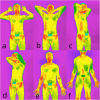Accurate diagnosis and effective treatment of abnormal meridians in erectile dysfunction patients based on infrared thermography: an electrophysiological technique study
- PMID: 38509346
- PMCID: PMC11860228
- DOI: 10.1038/s41443-024-00859-w
Accurate diagnosis and effective treatment of abnormal meridians in erectile dysfunction patients based on infrared thermography: an electrophysiological technique study
Abstract
An increasing body of research has demonstrated that appropriate stimulation of the meridians and acupoints in the human body can play a preventative and therapeutic role in diseases. This study combines the use of infrared thermography with intelligent electrophysiological diagnostic system (iEDS) to accurately diagnose and apply transdermal low-frequency electrical stimulation to treat abnormal meridians in patients with erectile dysfunction (ED). The treatment protocol included 6 treatments (each lasting 30 min and performed twice a week). The International Index of Erectile Function-5 (IIEF-5), Patient Health Questionnaire-9 (PHQ-9), Generalized Anxiety Disorder-7 (GAD-7), and Erection Hardness Scale were used to assess treatment results. A total of 62 patients were included in this study, with 31 patients in the treatment group and 31 patients in the sham therapy group. After six treatments, the treatment group improved significantly in IIEF-5 (15.52 ± 2.06 vs. 18.84 ± 2.67, p < 0.001), PHQ-9 (8.32 ± 6.33 vs. 4.87 ± 4.41, p < 0.001), GAD-7 (5.32 ± 5.08 vs. 2.94 ± 3.31, p = 0.003), and EHS (2.48 (2.00, 3.00) vs. 2.90 (2.00, 3.00), p = 0.007). After six sham treatment sessions, no improvements in any of the scores were reported in the sham therapy group. Following that, this group had an additional six treatments of regular therapy, which resulted in statistically significant improvements in IIEF-5 (16.65 ± 1.96 VS. 19.16 ± 2.40, p < 0.001), PHQ-9 (8.81 ± 6.25 VS. 4.97 ± 4.36, p < 0.001), GAD-7 (5.74 ± 5.18 VS. 3.68 ± 3.42, p < 0.001), and EHS (2.61 (2.00, 3.00) VS. 3.03 (2.00, 4.00), p = 0.003). No adverse events were reported regarding penile discomfort, pain, injury, or deformity. CLINICAL TRIALS: The study protocol is registered in the Clinical Trials Registry with the identification number ChiCTR2300070262.
© 2024. The Author(s).
Conflict of interest statement
Competing interests: The authors declare no competing interests. Ethics statement: For human study: The present study protocol was reviewed and approved by the institutional review board of Northern Jiangsu People’s Hospital for application (approval number:2020ky-073). Informed consent was submitted by all subjects when they were enrolled.
Figures



Similar articles
-
Early outcomes of short-course low intensity shockwave therapy (LiSWT) for erectile dysfunction: A prospective, randomized, double-blinded, sham-controlled study in Malaysia.Andrologia. 2022 Oct;54(9):e14518. doi: 10.1111/and.14518. Epub 2022 Jul 1. Andrologia. 2022. PMID: 35778368 Free PMC article. Clinical Trial.
-
Low-intensity extracorporeal shock wave therapy--a novel effective treatment for erectile dysfunction in severe ED patients who respond poorly to PDE5 inhibitor therapy.J Sex Med. 2012 Jan;9(1):259-64. doi: 10.1111/j.1743-6109.2011.02498.x. Epub 2011 Oct 18. J Sex Med. 2012. PMID: 22008059 Clinical Trial.
-
[Transcutaneous neuromuscular electrical stimulation for the treatment of erectile dysfunction: A clinical observation].Zhonghua Nan Ke Xue. 2022 Aug;28(8):691-695. Zhonghua Nan Ke Xue. 2022. PMID: 37838967 Chinese.
-
Erection hardness: a unifying factor for defining response in the treatment of erectile dysfunction.Urology. 2006 Sep;68(3 Suppl):17-25. doi: 10.1016/j.urology.2006.05.041. Urology. 2006. PMID: 17011372 Review.
-
Effect of Low-Intensity Extracorporeal Shock Wave on the Treatment of Erectile Dysfunction: A Systematic Review and Meta-Analysis.Am J Mens Health. 2019 Mar-Apr;13(2):1557988319846749. doi: 10.1177/1557988319846749. Am J Mens Health. 2019. PMID: 31027441 Free PMC article.
References
-
- Li Z, Hu YY, Zheng CY, Su QZ, An C, Luo XD, et al. Rules of meridians and acupoints selection in treatment of parkinson’s disease based on data mining techniques. Chin J Integr Med. 2020;26:624–8. 10.1007/s11655-017-2428-6 - PubMed
-
- Zhao L, Chen J, Li Y, Sun X, Chang XR, Zheng H, et al. The long-term effect of acupuncture for migraine prophylaxis: a randomized clinical trial. JAMA Intern Med. 2017;177:508–15. 10.1001/jamainternmed.2016.9378 - PubMed
MeSH terms
LinkOut - more resources
Full Text Sources
Medical

